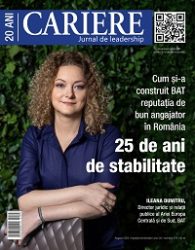Some crafts are getting lost; some keep up the tradition
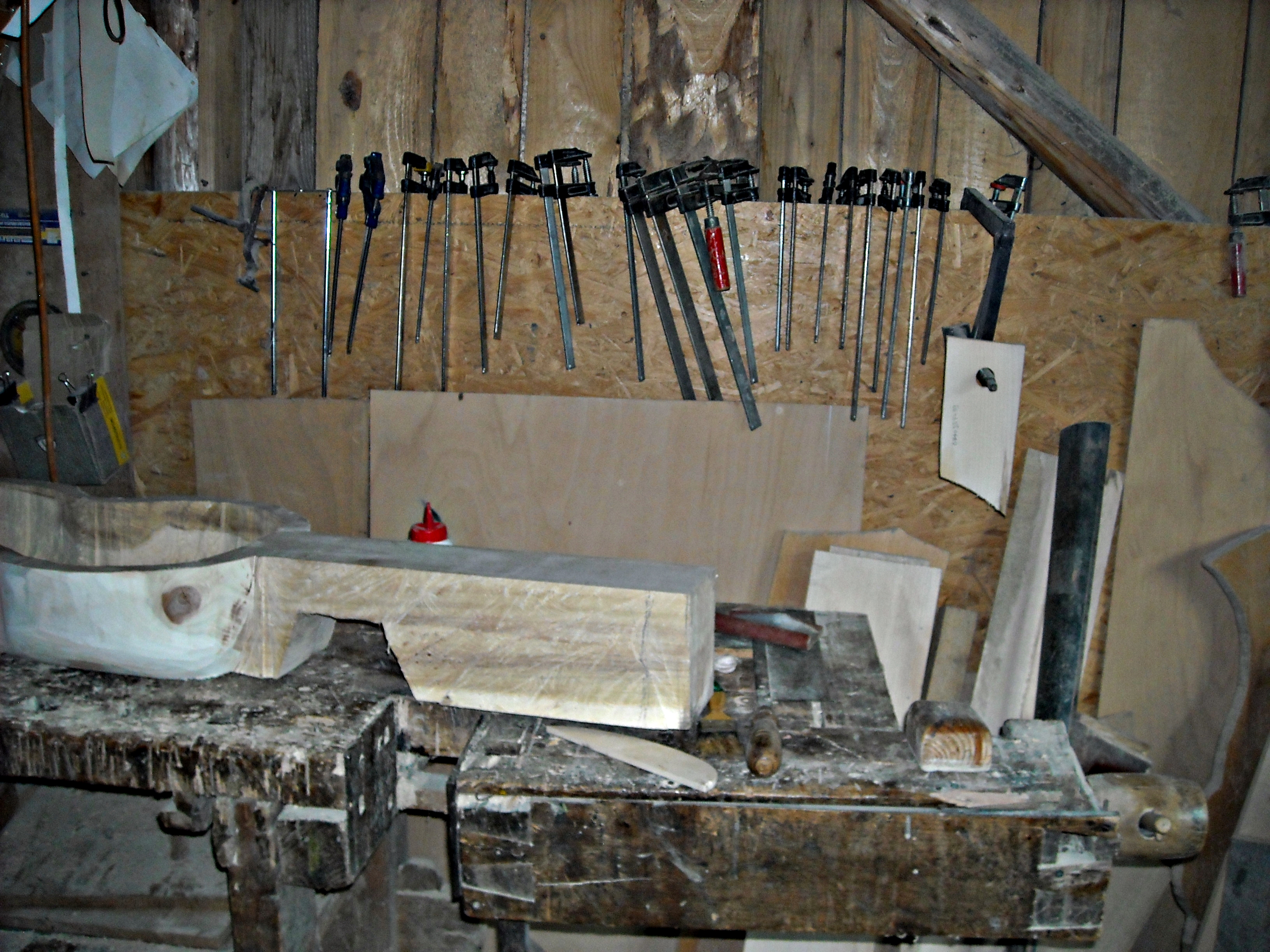
The journalistic project in Italy is focused on biological and social agriculture in the sense of community, also on old artisan traditions and new ways of being an artisan. We visited etnographic museums, biological cooperatives, as well as small creative artisan workshops. We visited a particular area of Northern Italy, that crosses four of the main regions: Lombardia, Emilia-Romagna, Liguria and Piemonte. Here is what we found:
All the roads meet at VALLI UNITE
“Our mission is that young people come back to agriculture as a lifestyle”
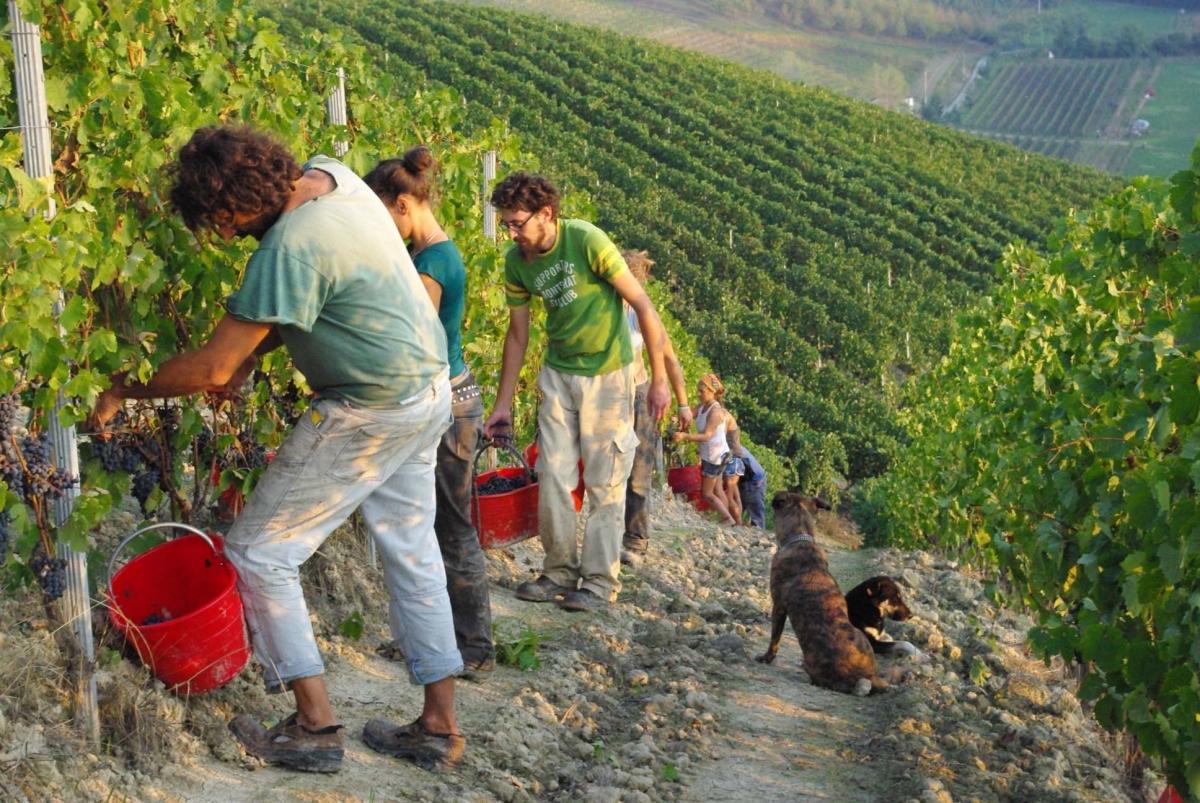
We leave the city and we start to drive up the hillside. The landscape is changing and the silent green hills outside Tortona are mild, even if he sky is cloudly. Soon we get to Costa Vescovato, the place we want to visit.
‟Valli Unite” is an agricultural collective cooperative, one of the biggest inthe area, one of the most important of Northern Italy, in terms of production and even more, in terms of organization. It is an open space, where young people, foreigners, unemployed, everybody who wants to try the experience of working in agriculture is welcome.
Here there's a good production of wines, (let’s not forget Piemonte is the land of “Barolo” wine) meat, fruits and honey. What makes this place particular and unique is that you have the impression to arrive in a place where you don't feel like a stranger. After our arrival, we take a look to the village, in fact, in The Valli Unite ten people live permanently, most of them volunteers, and now for instance there's also a visit of some people from Milan.
The structure is big, there's a farm for the animals, there are other houses for the volunteers, there are other houses for the residents, there's a store for the wines, there's a restaurant, and there's also a shop for all the products of the cooperativa.
We ask for an interwiew with Ottavio Rube, one of the founders, but he is busy. We get to the laboratory of honey and we met Asia, who is a student from Torino, and we get to interwiew her.
Asia Deangelis holds a bachelor's degree in Economy and she's studying for the Master in Sustainable Economy. In the final part of the Master program she chose to come her here for an internship.
In fact, Asia says that she has already a business project, an eco-village and she's here to train herself and to watch carefully the organization of “Valli Unite” to learn for her future entrepreneurial activity. Asia seems to have very clear ideas, she says “I want to open an ecological village in the mountains of Liguria, where disabled people and people with mental disorders can solve their problems through donkey assisted therapy". She looks very sure of herself, very clear in her ideas.
Asia says that the Chamber of Commerce of Imperia (city in Liguria, capital of county) is checking her project and if it gets approved, she may receive an amount of money to open the activity. When we ask her why use donkeys rather than horses she says “the donkey encourages a slow vision, a slow practice. Moreover, the milk of the donkey is precious as a medicine, we can use it also for making cosmetics”. She already found a name for her village, she'll call it “NatuRaglia”. It’s a very funny name, so we laugh together. She already has ten donkeys, but for the activity she needs at least sixty.
We also talk to Alessandra Marinelli, as she's one of the most important and old inhabitants of the cooperativa. Alessandra is a woman about 50 years old, but she looks definitely younger. She's the business woman of the village and also the marketing and sales person. Wine is the most important economical acitivity of Valli Unite.
She says they own about twenty-three hectars to produce wine, they produce up to 10.000 bottles each year. Alessandra says that Valli Unite sells the wines anywhere in the world. For instance, in England, United States, Hong Kong, Australia, Norway, but also in Italy, to many restaurants and bars.
She says today it is very difficult to produce wine in the old traditional system, that means without the use of mechanical tools and without any chemical additives. She also says that the Italian bureaucracy is very invasive, ‟of each 8 hours of work, three are dedicated to filling administrative procedures due to bureaucracy. It is too much”, she says, which we find it difficult to disagree.
Ottavio Rube, the founder and also the spiritual leader of “Valli Unite” is a man around 60. There is an expression of serenity, calm and tranquility that springs from his face and in front of him you feel at home. He starts by excusing himself for being late, he had many things to do before the interview.
He starts to tell us the story of the place, saying that there were three founders, three families that owned the lands in the sixties, who decided to share the property and found the cooperative. When we ask about the future, he says he is confident because they are able to involve many people, either young and not, very different from each other, so that the activity will keep on.
He keeps saying that “we must put the young people in the condition to come back to the agriculture” and we are sure in Valli Unite they're doing this. In the past, Ottavio struggled to involve the peasants of the valleys around to practice a biological agriculture and share the property, but with no return. He even tried trough political activity, but with very poor results.
He believes in the values of the agricultural lifestyle, that means a healthy lifestyle, hard work in the open air, in opposition to the modern comfortable lifestyle, where nobody uses their hands any longer, where the human relationships are based often on stress and competition.
He said that in the early sixties, the peasants and the people working in the fields couldn't even get married, for they were too poor and discriminated by the “citizens”.
Ottavio Rube keeps saying that he is faithful that the two sons that he has will keep on the philosophy received from their father and if they will go on with the cooperative, they will fight the same struggle of the father, to try to build a better world. He says that now there are around 30 people on this farm, only 7 between 20 and 30 years old, but surely the number of young labourers will increase.
Until he is not sure of the cooperativa`s growht, Ottavio will not retire.“Valli Unite” means the united valley and he will make sure it remains just so.
The Social Laboratory of Andi Fausto
Fausto Andi lives on the top of a hill. These hillsides are among the most important in Italy for the production of wines. Important and well-known wines as Gutturnio, Barbera, Bonarda, Creatina come from “Oltrepò Pavese”, the name of this valley, where Fausto Andi owns his winery, where he produces his precious and well-known wines. Oltrepò Pavese is an area in the extreme south-west of Lombardia region.
His farm winery has his name, but it is really precious for other reasons: he practices “social agriculture”. It coull be just one of the frivolous names that mean nothing at the end.
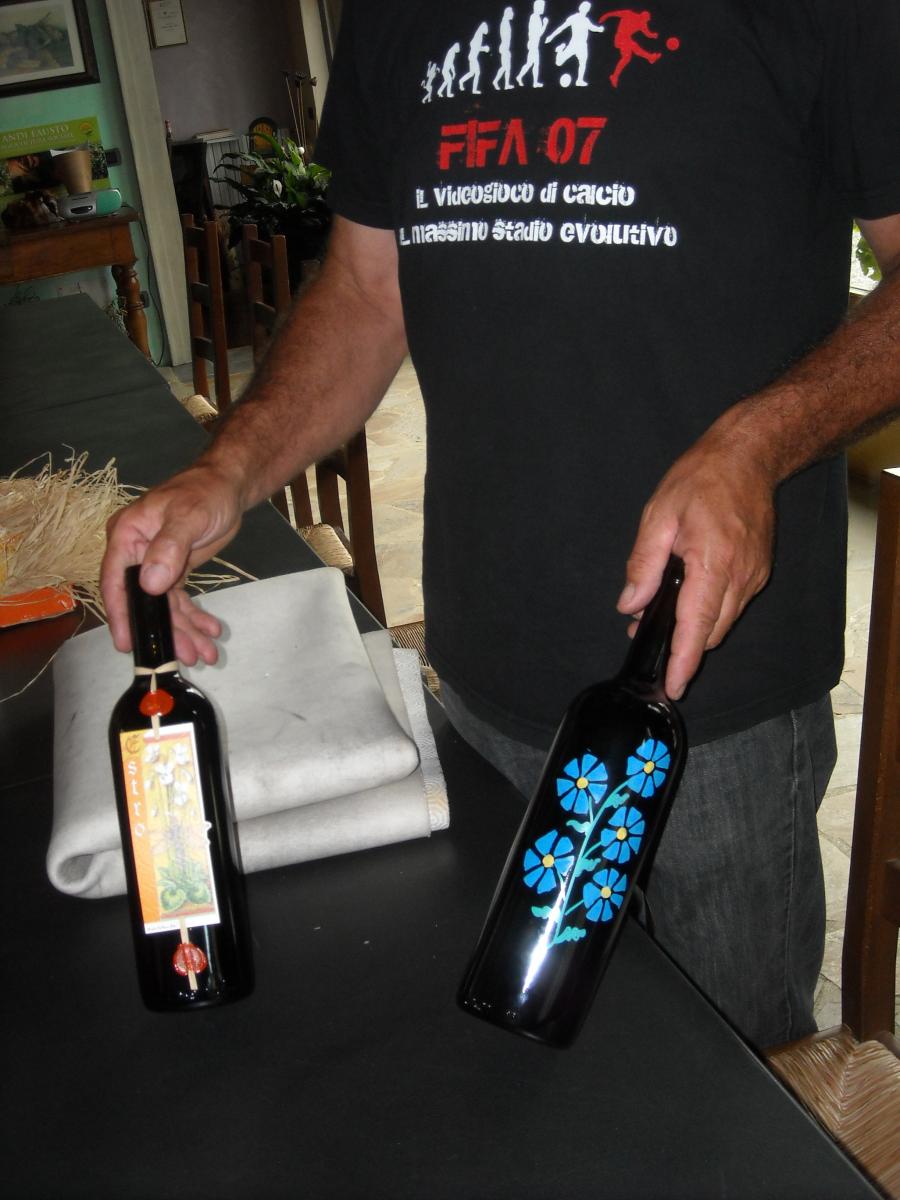
However, it is not the case of Fausto: he starts to explain to us what does social agriculture mean, and we find out it means working with twelve handicapped people (over 70% of invalidity) and works together everyday with them.
Mr Fausto is very proud of it. He says that their contribution is precious especially when the wine is already in the bottle: they package the bottles and they make the decorations, personalizing the bottles, the operation that in commercial terms we call “packaging”. Fausto is sure that he has one of the finest packaging of Italy, adding that he sells in Italy and abroad, they have no distributors, they sell just from the web-site and they focus on the quality of the product, respectively, that is the image of the farm.
He told us that, for instance, the famous Italian singer Adriano Celentano is an affectionate customer, he just bought 20 bottles.
The structure where we take the interwiew is an old country house rebuilt on architectural criteria of the 1600, very elegant and sober at the same time. This is really an island, a unique place and Fausto is quite aware of this.
We ask him what biodynamics agriculture means and he explains that is a spiritual-ethical-ecological approach to agriculture, food production and nutrition. Biodynamics was first developed in the early 1920s based on the spiritual insights and practical suggestions of Rudolf Steiner, whose philosophy is called “anthroposophy.” Today, the biodynamic movement encompasses thousands of successful gardens, farms, vineyards of all kinds and sizes on all continents, in a wide variety of ecological and economic settings.
Biodynamic farmers strive to create a diversified, balanced farm ecosystem that generates health and fertility as much as possible from within the farm itself. Preparations made from fermented manure, minerals and herbs are used to help restore and harmonize the vital life forces of the farm and to enhance the nutrition, quality and flavor of the food being raised. Biodynamic practitioners also recognize and strive to work in cooperation with the subtle influences of the wider cosmos on soil, plant and animal health.
In his vineyard, Fausto doesn't use any chemical substance, nothing to grow the grapes. He just uses some micro-organisms and essential oils to correct the growth. In this way, the plant is growing slower, it takes more time for the fruits to get mature, it is more vulnerable to the attack of the insects, but when the grapes are ready and safe, the wine you get is of excellent quality.
Fausto then shows us the cellars and the barrels where the wine is stored and they are made in original oak tree wood, which is the best wood for the conservation of wine. He then tells us that he preserves this system of making wine from the monks of Camaldoli, (i.e. Name of a famous monastry) the Benedectines. He did not invent the process, it is a way of producing wine that comes directly from the Middle Age, he just made some small correction to this unique system of production. He also said that the idea of mechanization in agriculture has to do only with quantity, but rightly, brings not progress in terms of quality and, above all, environmental impact.
He feels quite alone in his approach, Fausto, who has no ally among the small farmers in the valley who don't really care about the biodynamic wine system of production or of his social laboratory. When we finally ask him whether he his optimistic about the future of such social and biodynamic agricuture, he says that he is, because he believes that the respect for the environment and the care for the most fragile people will throw away cynicism and selfishness one day.
Thank you Fausto, we agree. If we want a change, we need men of this character!
Susanna Gasparini: Archaic techniques of making pottery, flint knapping, weaving and cooking
We drive alongside the Trebbia valley that Ernest Hemingway used to call “the most beautiful valley he ever saw”, to get to the Neolithic Village. We arrive in the small city of Travo, beside the river banks, that is the center of the valley.
Here we are going to meet Susanna Gasparini, one of the keepers and researcher of the Neolithic Village of Travo (situated close to Piacenza), one of the most important prehistorical villages of Italy. Neolithic Village presents a network of well-preserved dwellings and workshops, of which several can be visited.
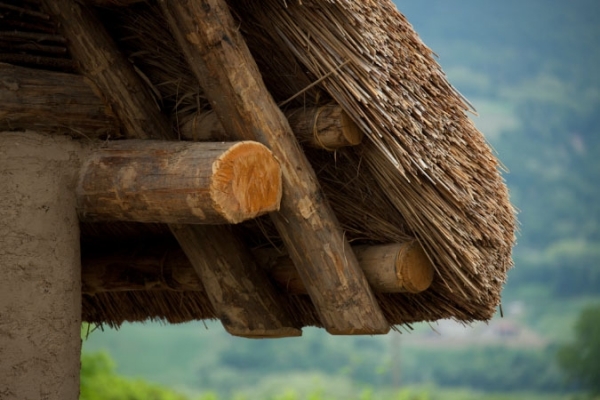
In this area the archaeologists reinforced with special resins the remains of the perimetric, rectangular ditches of two out of six huts identified in recent years.
Shelters were built to protect the findings. The shelters are made of wood, double-sloped and covered with thatch: they reproduce the same size, volumes and materials of the ancient huts. In the holes, dug up during the excavations, the archaeologists placed small poles so that the public can figure out the original shape of the palisades and fences in different places across the village. Near the southern boundary of the Park, one can see the ancient pebble fence, which is now protected under a crystal and wood roof.
The visit itinerary is provided with panels explaining the history of the site, the dwellings and workshops, our knowledge of the Neolithic, both in Italy and abroad.
Since 2010 one can also see a real size reconstruction of some Neolithic buildings, made of materials and furnished with objects that are copies of the ones actually found in this place. Inside the Park, special events are organised, a remake of the archaic pottery manufacturing and firing techniques, the chipping of flint stone, weaving and cooking.
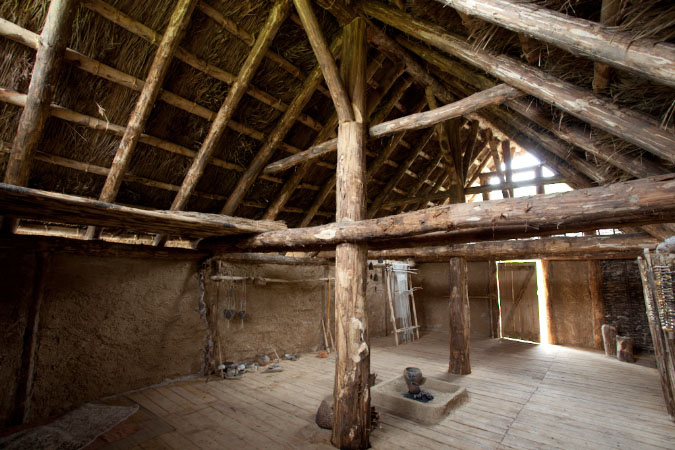
Susanna lets us in her small office, all made in wood. She comes from Belgium, and she studied Prehistory. She says they built the village here after, about thirty years ago, the archeologists have discovered that under the ground there were fossiles. There were above all traces of more than one Neolithic settlements in this area.
Those traces consisted mostly of pottery, but also other tools and objects. ‟The traces are basic to research, explains Susanna. The interpretation of the traces is equally important.”
Every weekend in the summertime, Susanna and other three or four people organize visits for the families and children. She explained to us that she believes in these visits for the families, because modern life is saturated by the use of technology and the children who are growning in the cities risk to loose the contact with nature, they risk to believe just in the artificial, and remain ignorant of the many things man used to build with the hands.
Susanna keeps saying that the main characteristic of the prehistorical time is a life without the use of metals. The men of that era just followed the rhythm of nature. So, when we start the tour of the village, we see the huts, all rebuilt in straw and clay. In the big hut, very large, the typical house of the neolithic, Susanna showed us how the men of the era used to make fire with the stones, various garments of the era, the animal skins they used to cover themselves with and the various tools they used. She explains us the archaic techniques of making pots, pottery, the flint knapping, the weaving and the cooking.
This new way of Eco-tourism is a very clever way to bring education and ecology together. Susanna and her team are passionate and enthusiastic to receive visitors and show them into a journey of another time.
Old traditional musical instruments of the “four provinces”- Ettore Losini “Banni”
Bobbio is an old Middle Age town, the capital of Valtrebbia. It’s the town where Saint Colombano settled in the Middle Age after a long migration from Ireland and where he built one of the most important monasteries of Italy.
Right in the courtyard of the monastery, a particular exhibition opens today. Ettore Losini, known as “Banni” for the local people is about to open his exhibition of old traditional musical instruments from the “four provinces”. (We are in Piacenza province at this point).
Ettore, a man of around 65, who lives outside Bobbio, has brought along about 30 pieces of his musical instruments, almost all of them handmade by him, from wood. During the opening ceremony, he plays one of these instruments (the piffero, a kind of flute), the “so-called” music of the four provinces, traditional folk music, genuine, pure.
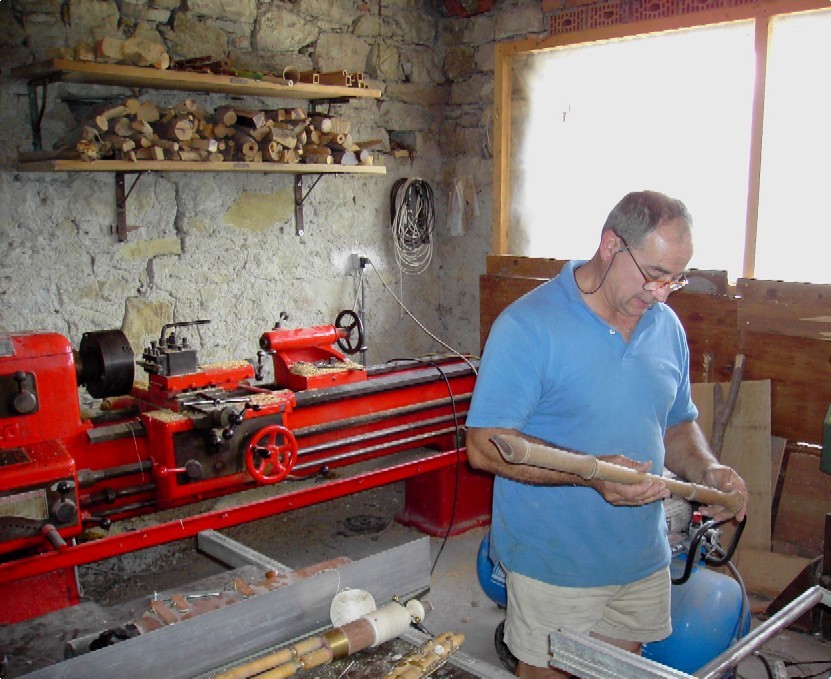
After his performance, he comes to us for a short interwiew. Ettore says that he doesn't have a true musical education. He doesn’t even consider himself a musician, but just a “player”. He learned to build musical instruments from his grandfather, a carpenter, and so he adds: “When I was a child I used to build toys by myself, I never bought one single toy”. He keeps saying that he prefers to build the instruments rather than play them, and his mission is to spread this music, the folk of the four provinces.
Banni tells us that he is inspired by these old classical instruments while he builds them, because “they have a heart, a colour, a life that the new commercial ones don't have”.
The first instrument he ever built was a “piffero” a larger kind of flute made in wood, but the easiest to make are “the oboe and clarinetto”. He likes even more to build “Piva, Musa and Flauto pastorale”, that are all ethnic intruments of the four Italian provinces. Ettore loves also to make his own wine, to paint and even to be a plowman. When we ask him if one day he would like to open up a school, he says no, but he would love to transmit his knowledge to someone, all the more he doesn't have a son.
Stefano tells Ettore that he would like to make an agreement to be taught something about the art of building an old flute, il Piffero, to which he agreed happily. Finally, Ettore tells us that he is invited in some ethnic festivals of Europe, be it in Scotland, Berlin, or Inssbruck. We also find out that his name is well-known in the circles of “aficionados” of folk music in Italy. He totally deserves it.
The glass artisan – Giacomo Bergonzi
We met Giacomo Bergonzi in a street exhibition called “Bascherdeis”, up in the hillside of Piacenza. Giacomo has a little booth, where he shows his beautiful craft of glass decoration. He's a very nice man, around fifty years old, very sociable and he's surprised to meet us, he never had an interwiew before in his life.
Mr Bergonzi tells us that he's a self-made man. He worked for about fifteen years in an industrial glass work factory. There he learned his craft step by step, studying, wachting the different ways of working with glass.
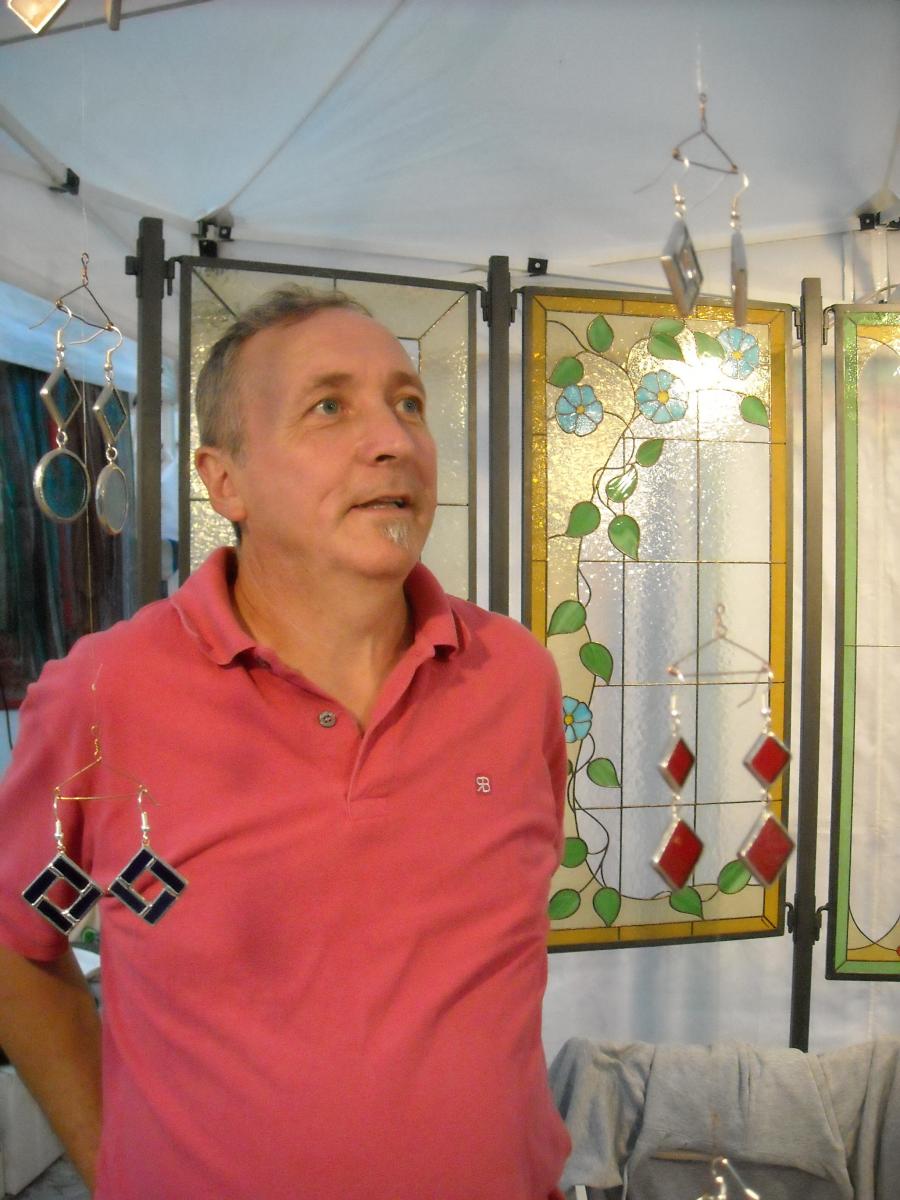
In some years, when he got good skills, he decided to stop working for others and start his own activity as an artisan of glass, precisely to make stained glass windows. Giacomo says that his inspiring models are the glass windows of the Middle Age, or even Marc Chagall’s windows in The Fraumünster Church in Zurich.
Giacomo Bergonzi says that he decides together with his customers what model to choose, what kind of decoration they want, and then he starts to cut and design. He also said that everybody is worried about cutting the glass, but in fact is not really dangerous, he's never been hurt. To him, cut and work on the glass is like learning to ride a bicicle…
When we ask him if one day he would like to have people to learn his craftsmanship, he says it would love it, but is very difficult, also for the reason that there's a lot of burocracy to regularize an artisan apprenticeship activity, and unfortunately his sons are not very interested in learning and keeping his activity.
That is a big loss for the Italian economy, we think, if the politicians don't care about these issues, of how to create the conditions to maintain the small producers. Italy that is based strongly on the small producers and artisans will slowly decrease and destroy its economy.
Angela Ricci, The Director of the Museo Etnografico della Gambarina
Everything ends with the journey in another time ( The Ethnograpy Museum, Gambarina)
You walk slowly outside the center of Alessandria, and you arrive in this square that reminds of an old fashioned country architecture, in fact there's the entrance of the Gambarina museum. So once we climb the stairs we get to watch old devices that were used for agriculture, mostly in the wine production and when arrive at the second floor, lots of old dolls, and old panels of advertisements of the “fascist era” startle us.
We enter the room of Angela Ricci, the director of the museum. A 65 years old retired woman, who does this job as a volunteer. She likes her job a lot, she performs it with enthusiasm, she believes in it, and above all she likes to share her knowledge on traditions with others. She says that the idea of the museum comes from a long time ago. Precisely, in an elementary school in Alessandria, after the World War II, where the children liked to search for old fossiles in the country side, during the fifties. The children of one particular school were taught and guided to start to have a taste for ‟collecting”. First, they developed an interest in minerals and shells. The grandmothers and grandfathers used to bring the children beside the Tanaro river in the springtime to discover all those minerals. So they were gahtering a lot of old objects and collected them. At some ponit, they needed a common space where to put them together. In this way, the idea of a museum of old traditions was born, obviously strictly linked to the story of the territory in Alessandria.
Angela works with a small team of volunteers like herself, four or five people, who prepare information files and photos, they accompany tourists, and do the various curatorial jobs of the museum. They also organize festivals of folklore in the territory, showing people some of the old traditional jobs, such as weaver, shoe-maker, cheese maker, wine maker so on and so forth.
We start to take a tour of the museum and Angela is our guide. We go on the first floor, where there's the major part of the collections. This part, in particular, shows the various aspects of the old lifestyle such as scenes of the life in school, the children`s toys, the kitchen, the bedroom, the soldier, the marriage, the various aspects of craftmanship, such as carpenter, plowman, shoe-maker etc.
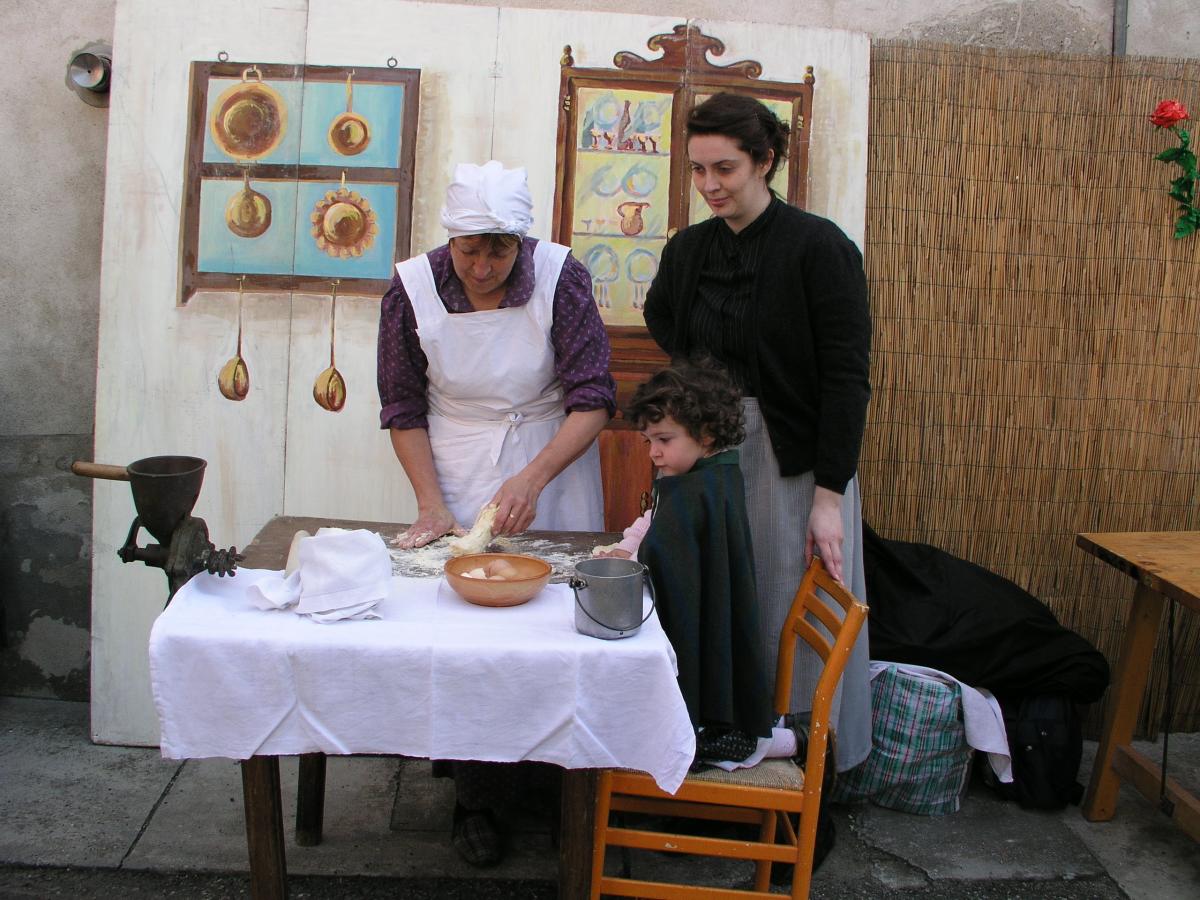
On the second alley, the curator shows us the different objects of the life besides the river banks (that flows close to Alessandria), with the old fishing objects used by the fishermen 50 years ago.
The way Angela tells and explains the traditions and the story of her land shows great passion and involvement. In a very convincing and intelligent way, she is capable to involve us in the atmosphere of the old habits and traditions exhibited by the Gambarina museum.
"Everything Starts with the Touch (and Smell) of Leather"
Ioan Nistor, the leather craftsman
After you climb the stairs of the Furrier's Tower from Sighișoara, you will reach the leather craftsman, Ioan Nistor workshop. Everything from regular girdles or girdles with pockets to belts, sandals and bracelets is thoroughly done by one of the last guild members whom you can meet in the old city, once full of powerful guilds of craftsmen.

Ioan Nistor started working with leather in the 70s, 2 years after his apprenticeship. First, he made shoes, then leather objects and in the end he handmakes leather objects. In former cooperatives, the people used to learn this craft from traditional craftsmen. He learned everything of how to make leather objects from A to Z from Denis Zoltan. “He used to tell me that I work better than him and that my craft is more beautiful. He also told me that my craft was innovative. He was a man who worked all his life and enjoyed it. He died when he was 90. We, humans, feed ourselves and our spirituality by our working.”
62 year-old Ioan Nistor says that nowadays it is very difficult for the leather craftsmen to keep on with such work because it’s not lucrative. Many craftsmen abandoned it and they started trading, so they can support their families. They lost their touch because they don’t practice anymore. Many crafts disappear slowly. There are only two or three watchmakers in Sighișoara, one tailor and two shoemakers left. In the past generation, the cooperatives used to have ten-fifteen repair shops. “There were workshops for custom-made production and workshops for mass-production. There were up to twenty tailors in a cooperative. There were hat makers at that time. But all these crafts started to disappear. You can’t have a job like this without any kind of support. It can’t provide a decent standard of living.”
He himself is considered a tourist attraction, and because of this, many tourists come to visit his workshop; yet, he complains that often a time he earns just 15 Romanian lei per week from selling to tourists. “We would like to be protected. The authentic products should have the traditional handmade by a craftsman’s logo. The difference between authentic and unauthentic products, which are sold in regular markets, should be visible.”
He believes that the tourist objectives are equally important to the traditional crafts in Sighișoara. “It would be wonderful to have guilds again. We would like to get this project going, so that the tourists would have a lot to see by the time they come. The hotel- and restaurant- owners should be very interested in this project. Their profits will increase if more tourists come here. The more we promote tourism in the Citadel (the historic Centre of Sighișoara), the more we benefit; all this helps us grow.”
His craft shop from the Furrier's Tower is closed during autumn and winter, so he can’t sell during this time: I need to save money for those months. It is too cold in the Furrier's Tower to stay here during these months.
Ioan Nistor believes that the traditional craftsmen could be exempted from paying taxes if they prove their craft is at risk of extinction. He is among the lucky ones because he enjoys the patronage of “Mihai Eminescu Trust” foundation. This foundation has helped him stay in the Furrier's Tower because this tower is a part of Sighișoara’s historical heritage. He is lucky because his daughters wanted to learn the skills of his job. The same goes with his only nephew. “I haven’t seen any other youngster to be so interested in this. You learn the ropes of a job and its secrets in time. In this way, you can make your contribution to the process. I compare the lack of practice with knowing only the alphabet. You need to contribute in some way, so you can create new things.” His belief is that someday the young people won’t have where to work and they will return to traditional crafts. The employment crisis has already started; mobility won’t be gladly accepted anymore in Europe. Then the young people will return.”
Ioan Nistor is a respected man for his craftsmanship both in and outside of Sighișoara. People know him from the specialized arts and crafts markets and they look for his items. “I have always worked for the people and I have always made a great product, so that nobody regrets when buying it. The people saw this and they look for my work.”
He shows us a pair of shoes handmade by him, which are to be stitched by his children. He shows us the riding whips, the horse and cow whips and the cattle breeder whip. He doesn’t put the cattle breeder whip back in the hanger because there is somebody already interested in buying it. The black or brown girdles are manufactured according to the Târnave region – Mureș, Făgăraș, Brașov. The custom-made ones, either black or brown, without metalwork, are very popular among the folk music dancers in the area. He has on his wall such a unique piece. This girdle is 100 years old and is the craftsman’s model and museum piece.
Be it a custom-made bag, whip or leash, Ioan Nistor manufactures the leather items so ardently, that he has a hard time giving them away. “I put all my effort in manufacturing these items; all my love, patience and skill are there. I wished I would keep every item for myself.”
Like Father, Like Son. Nicu si Nicolae Cezar, the Watchmakers
The famous horologe with figurines of the Clock Tower, the symbol of Sighișoara, dates from the XVII century. At first, the clock used to show the hours only; Master craftsman Johann Kirchel from Konigsberg (Kaliningrad), improved its accuracy in 1468, so that the clock would strike every 15 minutes. He also equipped the clock with a minute’s clock hand and a mechanism which makes movement visible during the day. This mechanism contained seven 80 cm figures carved in linden wood which showed the days of the week.
The clock and the figurines may have been destroyed in the 1676 fire and remade by the same master craftsman. The old clock mechanism was replaced by another one which was produced by the Swiss company Fucks und Sohn. Fritz Konrad equipped the clock with an electric mechanism in 1964. The tower clock is being guarded nowadays by the watchmaker, Nicu Cezar.

We met Nicu Cezar, the watchmaker who is responsible for the horologe with figurines from the Clock Tower in Sighișoara, while he was working in his workshop. He describes the original clock as “a mechanical clock modernized with an electric engine in 1964. Nowadays it works on an electric engine. It has a complex mechanism, accompanied by seven figurines which mark the day and the night alternatively. These figurines are bound to the clock by all sorts of levers. They change every 24 hours. The striking clock sounds at every quarter, half an hour and every hour. "
The horologe hasn’t benefitted from a full revision in the last 50 years (at least) because of lack of funds. Because of this, the clock has an error of 2 minutes during the day. Nicu Cezar goes to the tower every 2 weeks to set the clock right. “It is a clock which was manufactured in 1906. I would like to see a watch manufactured nowadays which would work in 2114 too.” The job requires patience and good learning skills as things change rapidly in this domain. And also, a good master craftsman who can teach you. He learned this job from his father. He finished high school in 1990 and could have chosen to go to a university. But since he was the only one in the family who could help his father to manage his watchmaking workshop opened after the Revolution, in the end, Nicu chose to stay by his father to learn.
“Satisfaction comes when you get a lifeless watch and you give it life.”
His father, old Nicolae Cezar was born in Mediaș, but moved to Sighișoara since he was 14. He started as a trainee in 1962. Before that, he worked in optics, watchmaking and jewelry making. "I went to school and studied watchmaking for 3 years. There was a refugee from the Republic of Moldova as our master craftsman, and I learned from him. In those times, when training was provided by master craftsmen, you had to pay attention to what they were doing. You had to get the tricks and remember them. My son got this know-how from me. Unfortunately, many crafts get lost. I think it’s the system to blame. After the Communism fell, professional schools were disbanded. When you think about it, we were the first watchmaking school. The school was established by the Russians in Galați and the training lasted 3 years. When Romania started producing alarm clocks with the brand Aradora, the school moved to Arad.
Nicolae Cezar is worried because people prefer to buy cheap, low-quality watches. When they break, they throw them away. However, he plans to pass the know-how to his youngest grandson because he has what it takes: “He is very interested in this, he is curious and has the right skills.”
Nicu Cezar, the son, is of the opinion that there is need for schools and paid master craftsmen to teach the young. “If Sighișoara invests in trade schools, there will be enough people who can continue this traditional craft. If not, there won’t be.The youngest watchmaker from Tg. Mureș is 50 and the one from Mediaș is the same age. Traditional craft jobs have a historical value. In a craftsmen town, the authorities should promote the survival of these traditional crafts in Sighișoara.
The Mask Manufacturer
In the North of the Moldavian region of Romania, Iași County, in the small city of Hîrlău, Bogdan Bîrzu manufactures traditional masks. This is his hobby since he was young. He learned the craft from the young people of the city which were manufacturing their masks for the New Year's Eve festival. He also learned from a skilled elder from the city who was called "The Dutch"; he was the one fixing everyone’s bikes, making wheels, building carriages. "He was an expat, claiming a Polish heritage, but I believe he was an Ukrainian. But mostly, he was very skilled in manufacturing masks".
Although he is an educated person, Bogdan gets his inspiration from the tradition that was passed down from generation to generation, refusing to rely on scholar books due to the inaccuracies of the written texts: thoroughly field work was never done on the subject.
Those who wear the masks are more like an entertainment assembly. The masks were the main attraction in assemblies such as "Alaiul Caprei" (The Goat's Ensemble), "Alaiul Cerbului" (The Deer's Ensemble), "Alaiul Ursului" (The Bear's Ensemble). These traditions have their roots in ancient rituals for the soil's fertility. "The masks are quite frightening. Their purpose is to scare away the bad spirits from the houses and courtyards the dancers are visiting. After the dancing ritual, the assembly cheered for a fruitful year for the hosts. The hosts were then rewarding the dancers with bread, fruits or money." These customs date from pagan times, they were inherited from the Dacians and later taken on by the Romans. Central masks like “Ursul” (The bear), “Capra” (The goat), “Cerbul” (the Deer), Caiutii (The Horses) are some of the most notorious along other masks. Mr. Bîrzu thinks that back in those times, the hunters wore the masks to tame the spirit of the animals. Alongside the masks based on animal figures, two other models are very familiar – the ones depicting "The Foremother" and "The Forefather", two iconic figures in the Romanian tradition.
The masks' models differ from village to village, depending on the dancers’ origin. Bogdan Bîrzu recently took part in an international project including participants from Spain, Italy, Croatia, Poland and Bulgaria. The purpose of the project was to promote the traditions regarding masks rituals. Bogdan Bîrzu was surprised to find out on that occasion only that such traditions are widely spread across Europe, only the celebration takes place in different times of the year.
Mr. Bîrzu„s favorite mask is the model called "Masca de drac" ("the Devil’s Mask") used by the “Alaiul Cerbului” assembly. The mask is made out of hair from a horse's tail. "This is the mask I grew up with in my region; it was used by the local dancers to greet us during the winter holiday season. They were very frightening, but the mask's richness was outstanding. Both the music and the dancing of the mask wearers were so beautiful.” In Hîrlau, the tradition is still kept alive: “Here, the dancers go each year from house to house during the winter holiday season. It's not like in other regions where only occasionally the mayor invites over the dancers or organizes an exposition with the masks."
Bogdan Bîrzu teaches arts and crafts at the "Petru Rareș" General School from Hîrlau. Being afraid that these traditions will fade away, he tries as much as possible to pass them on to the future generations. “In the past ten years I interacted with very skillful children. They won the 1st place at the National Olympiad of Traditional Arts and Crafts which takes place in the Astra Museum of Dumbrava Sibiului, Sibiu.” Alongside the mask crafting tradition, Bogdan Bîrzu also teaches the children to paint on wood and glass, to decorate eggs, to make decorative sculpture – mostly everything related to the Romanian traditional crafts.
Csibi Szabolcs, The Instrument Crafter
We met Csibi Szabolcs while he was crafting a type of cello which goes by the name “gordună” in Ghimeș area. This region is famous for its international festival called Gyimes Folk Dance Camp which takes place in the first week of August. The region has a rich and unique folklore. The folk dances, the specific clothes, along with a particular type of musical instruments – all of them are unique and the local music players are known internationally.
Szabi crafted his first traditional music instrument in 1998, when he was 23. He graduated from the Forestry High school located in Târgu-Mureș. This was the place where he learned how to craft wood. Once he moved to Sfântu-Gheorghe, he started to be interested in music and traditional music instruments. He started playing the folk pipe and the cobza. He built his own cobza mainly because he could not afford to buy his own instrument. He learned how to play it from friends who were also beginners in fiddle making. Many people influenced him, but he is thankful to Ferenc Tamás and Ferenc Ianoș in particular.
He wanted to improve his fiddle making skills, so he used to dismantle and assemble old musical instruments. His motto in the fiddle making area is “don’t build up an instrument which you can’t play”. He plays both the cobza and the gorduna, so now he builds cobzas and gordunas to his taste. Gorduna looks like a cello, but it is more like a drum with chords. The drum is built from a single green hornbeam piece. “If we start in the morning, we have one drum done by noon. Then we leave it to dry. It needs one year to dry. Willow tree is also used for building the resonance box. When the year has passed, we take the drum and we give it a final touch. We grind it on the outside layer, we make it thinner. We use our fingers to check if it sounds alright and after you craft many gordunas, you know when it’s ready. When it’s ready, you assemble the spruce fir lid. We glue the two thin boards together. After we assemble the lid, we check again with our fingers how it sounds. If it’s alright, that is all. We try to use local materials, not exotic ones. We do exactly how it was done in the past. We build up the tuning keys, we add the chords. The chords are made from sheep intestines. In the end, we add what is left. You spend another week to get the instrument ready. Everything from cutting the wood until the gorduna gets into the player’s hand it is done here.”
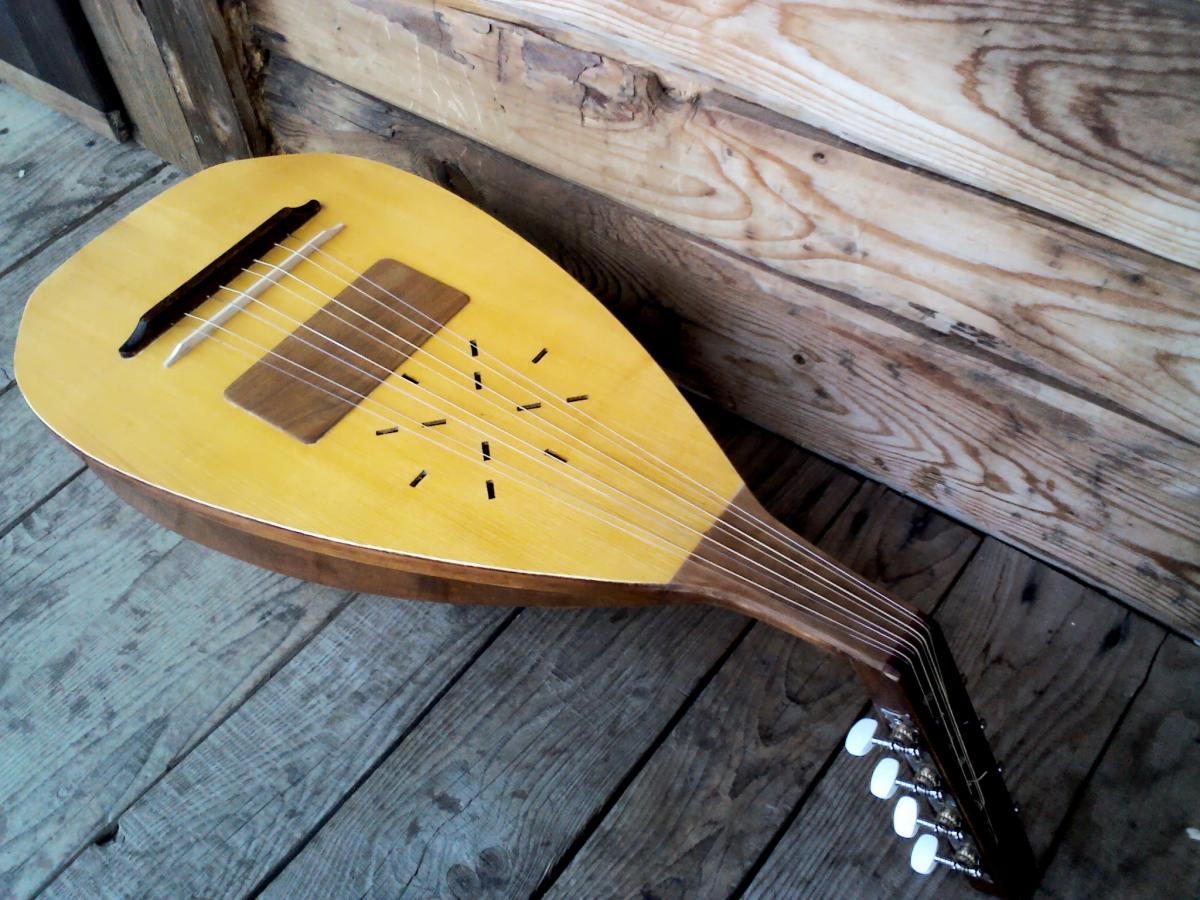
Despite the help he gets from his friend Érsek Csaba, he only crafts ten gordunas a year. Besides his fiddle making activity, Szabi has concerts with other musicians in his free time. He plays the traditional music from Ardeal region and Moldavia (Bacău area). He memorized the songs and their accompaniment from the traditional musicians called “lăutari”. “I went to their homes; I met them at festivals and at traditional music workshops.” Szabi mentions that the gipsy musicians remember most of the old songs. “Let’s assume that on one side there are Roma populated villages and on the other side there are Hungarian- and Romanian- populated villages. The gipsy musicians remember which songs are specific to which of these villages better than the inhabitants themselves.”
Szabi is representative for the folk music revival process, which started thirty-five years ago. Some Hungarian-ethnic young intellectuals found out that the young people were meeting in a particular village in Cluj in a “house of dance”. The students from Cluj used to go there because they believed it was extraordinary; they fell in love with the traditional music played there. They started playing various instruments and going to balls and this became really popular. In the 80s, almost every city hosted a folk dance house. The Hungarian-ethnic young people gathered here and they danced accompanied by traditional music. There used to be similar gatherings in Hungary. Those were better planned because the organizers themselves were professional dancers. This type of events became so popular that they became famous in the whole world. These young intellectuals were against disco music which they believed to be kitsch. Their goal was to bring traditional folk music to urban cities: “Let’s learn how to play just like the peasants or the gipsies or like the traditional musicians. Let’s play this music for people like us.”
We had the chance of listening to Szabi playing to cobza and gorduna along with other musicians in the Gyimes Folk Dance Camp from Lunca de Jos. At least ten young intellectuals had the chance to have a live cultural exchange with six older musicians. Pupils join this camp, but also their families who want to practice dancing. The singing and dancing lasts until four in the morning. “There are various regional songs, but the people know them as a result of the folk music and dance revival process. The people identify the songs by their region «Oh, this is the music of Pălatca village.» Or «Oh, this is the music of Izvorul Crișului village.» Such camps would be organized weekly from the beginning of July until the end of August.”
In the camp, Szabi teaches the others how to play the cobza during the day. During the night he plays music from Moldova region (Bacău area). He learned it from the old people. He made recordings and he learned after them. Some recordings date back from the 60s. “One could see how a song from a particular village changed with time based on the recordings. We could see how a musician played a certain song in his 30s and how he played the same song in his 60s or 70s. We need to stay focused because the whole process is very complex. We use to talk among us about what we could teach the younger generation who wants to learn from us. We can offer them more information than we knew at their age.”
Szabi thinks that the young people want to learn the traditional music because of the dance. “It is like a trend which needs such instrumentalists, capable of playing such music, to survive.” He and his friends are invited weekly to play for the children in kindergartens. “Through dancing, these children learn how to feel good with their bodies; even though they never intend to become ballet dancers.”
Szabi compares this folk music revival phenomenon with the Irish music one. His opinion is that the world-renown Irish music phenomenon had better management and better relevant connections with USA.
“The authentic folklore of any people is an extraordinary basis for creating a new music; even that basis can offer a high level of satisfaction. In central and West Europe, the folklore has been lost to a certain extent. The folklore shown on TV stations is superficial and it’s different from the authentic one, which is present in villages.”
Szabi has two interrelated passions: to play the instruments and to craft perfect ones. What is his motivation? “It’s a thing which draws me. It’s some sort of journey to the past whose end goal is not the preservation of a particular type of music. This journey, which uses high-end materials, makes you more open-minded.
Ionut Bâscu- The symbolism in the pottery of Horezu
Horezu ceramics is produced since a long time in a small village from northern Oltenia. A young man from Horezu city called Ionut Bâscu explained us how is it to make clay objects.
“The first step is to model your clay pot. The clay pot must be left to dry for a couple of hours; maybe even a day. Once the clay pot is completely dried, you can start painting it.” According to the tradition, the men are in charge of modeling the pots and the women paint them. “I model 200 items per day and either my grandmother, sister or my mother decorate them. In the meantime, I’m crafting new ones.” There is a symbolism next to modeling. “Cocoșul” (the rooster) is the symbol of Horezu area, “peștele” (the fish) is the symbol of health, “pomul” (the tree of life) is the symbol of knowledge, eternal youth and wealth, “cucii” (the cookoos) are the symbol for marriage. Some clay pots have the following decorations on them: „coada de păun” (peacock’s tail), “frunza de stejar” (oak tree leaf), “spic de grau” (wheatear). All the decorations from the pot are unique in a way.
Women use their imagination just like the painters and they don’t decorate another pot in the same way twice. Once they are decorated with paint, the pot is given a final elegant touch by abrasion. The pot is left to dry really well again up to one week. Then, they are put in the oven for 6 hours at temperatures from 800 to 1000 degrees. Then they are lacquered. The enamel they use is called “litargă”. Once the pot is in the oven, it is orange at the beginning. Once the temperature increases to 1000 degrees, it gets transparent and hard. Ionut shares that he can work at a single item up to 3 weeks. They usually make more.
“To prepare for this job, you shadow a master craftsman”. Ionut saw his grandfather how he used to work and he started to learn all by himself. Each has his or her technique to model the clay; there are some who make it thinner, there are some who use a different method.
“I have analyzed the work of many and I managed to have my style in the end”. Ionut is the only young man from Horezu who works with clay out of pure passion. With the help of someone like him, the pottery of Horezu could remain famous. In theor household- the Iorga family,- grandfather Gheorghe and Grandmother Maria work along with their grandchildren. They follow the tradition of the priceless Horezu ceramics. The village inhabitants organized a clay craftsmen market in order to sell their products called “Cocosul de Hurez” and it runs every year on the Stejari highland.
Conclusions
The goal of the field work carried out at the end of July was to get in touch with tradition in terms of craftsmanship, arts and crafts. We wanted to raise awareness among people about the importance of preserving traditional craftsmanship. Traditional crafts are passed down from generation to generation by apprenticeship as part of our culture.
We wanted to advocate the need of preserving such crafts because they are intangible cultural heritage. Our intention was to raise awareness about how important it is to pass down all knowledge and craftsmanship skills associated with traditional arts and crafts; in this way, the local artisan production continues to be the bread and butter of local communities. We would like the local authorities to reflect for finding a way to preserve traditional arts and crafts.
Many arts and crafts imply “secrets” and certain know-know which should not be uprooted. It is believed that sharing this type of information is against traditions. However, many a times, family or community members are not interested in the learning process, technical aspects or that particular art or craft. As a consequence, crafts can disappear.
We hope to convince local authorities to support local artisans to continue to create items, but also to pass down the skills and technical aspects within their communities. Our research methodology implied going to local markets, but also villages or cities from different regions like Brașov, Sibiu, Horezu and Brașov/Sighisoara
The project in Romania focuses more on small artisans and producers. The project in Italy is focused on folk music artists and traditional drinks and products from northern Italy.
